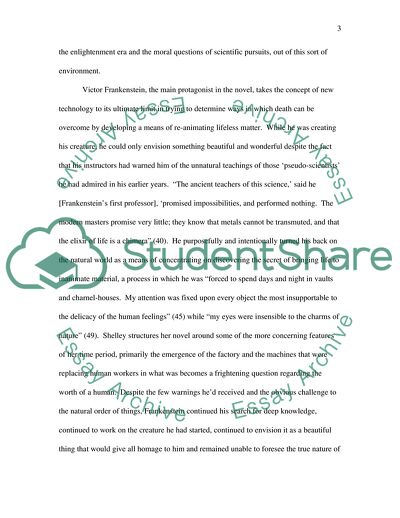
- Home
- Free Samples
- Premium Essays
- Editing Services
- Extra Tools
- Essay Writing Help
- About Us
- Studentshare
- Subjects
- Miscellaneous
- Frankenstein - - Enlightenment
Frankenstein - - Enlightenment - Essay Example

- Subject: Miscellaneous
- Type: Essay
- Level: Undergraduate
- Pages: 4 (1000 words)
- Downloads: 0
- Author: eliseoblick
Extract of sample "Frankenstein - - Enlightenment"
The rising middle class began breaking down the old class structure that had formed the backbone of European society for so much of its history just as advances in technology and machinery touched off new debate regarding the existence of the soul and the nature of God. Charles Darwin’s Theory of Evolution touched off new debate as well regarding the veracity of the Bible itself. With the availability of new jobs in the cities, traditional women’s roles were also being challenged as more and more young women sought better futures for themselves within the factory setting.
The public was becoming more and more involved in the social and theological debates being waged, particularly as newspapers and other periodicals became more prevalent with the introduction of the printing press, introducing and maintaining widespread discourse in the political and social issues of the day. Many of these aspects of daily life and culture, including the changes that were taking place, were reflected in the novels being produced. Issues such as enlightenment and its positive or negative ramifications took center stage in many of these stories.
It is not surprising that Mary Shelley should produce a work such as Frankenstein, with its deep investigation of the enlightenment era and the moral questions of scientific pursuits, out of this sort of environment. Victor Frankenstein, the main protagonist in the novel, takes the concept of new technology to its ultimate limit in trying to determine ways in which death can be overcome by developing a means of re-animating lifeless matter. While he was creating his creature, he could only envision something beautiful and wonderful despite the fact that his instructors had warned him of the unnatural teachings of those ‘pseudo-scientists’ he had admired in his earlier years.
“The ancient teachers of this science,’ said he [Frankenstein’s first professor], ‘promised impossibilities, and performed nothing. The
...Download file to see next pages Read MoreCHECK THESE SAMPLES OF Frankenstein - - Enlightenment
Literature mary shellys frankenstein
An Analysis of the Enlightenment Themes in Mary Shelleys Frankenstein
Character & Theme in Mary Shelley's Frankenstein
Frankenstein by Mary Shelly
Mary Shelleys Frankenstein and the Romantic Culture
The Healing Power of Nature in Mary Shelleys Frankenstein
Frankenstein as a Criticism of the Enlightenment and Romantic Movements
Contexts of Pre-Novel Narrative: The European Tradition

- TERMS & CONDITIONS
- PRIVACY POLICY
- COOKIES POLICY